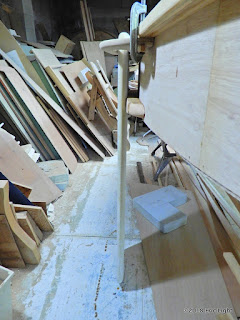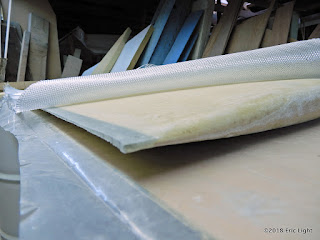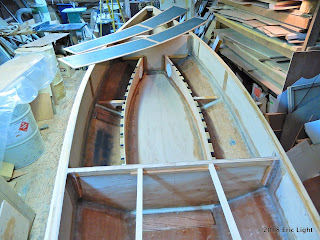The benches as drawn looked very low, so I was curious all along to see how seats would work in this boat that was designed to have a completely open cockpit with no furniture at all to clutter what could be a sleeping platform.
So after the glue* for the seat tops had cured, I humped the boat down off the workbenches and got into it. I put the camera on a ladder rung with a little wedge of hard foam under it to point it downward. 10 seconds was barely enough time for me to get into the boat and look at the camera, which is why it didn't catch me smiling:
I think it works well for me, so I'm happy. The seats are a little low, but the height of the back rest is good. Too bad I didn't think to place the decks on for the photo!
In the forward storage space (bottom of the photo) the bottom and sides have been glassed with 1.5-oz mat in anticipation of anchor and chain wear.
The benches feel totally solid; no flexing under my weight. The sprawl feels a little tight, but I'll go with it. I enjoy that there's no centreboard box breaking up the footwell area.
Lots of grinding and sanding to do now, to round all of the corners, then glass mat will go on all of the joints.
* For glue I used resin with chopped glass strand and a some microballoons to thicken it a bit. I've gone all-in on polyester resin for this boat, since it's so much easier to use:
• the ratio of base to hardener is not critical: in the winter, use more hardener
• mixing is not as critical; epoxy really needs to have the two parts mixed well
• it cures much faster; within hours as opposed to days for epoxy in the winter
• WEST epoxy has a blush that needs to be washed off
• if unwaxed polyester resin is used, no sanding is needed between coats
Update: Correction: I haven't exactly gone "all-in on polyester", since I used Titebond III for laminating the gunnels and for other wood-to-wood gluing. (I also tried out Gorilla Glue for the first time. I like it because it's so fast, but I prefer Titebond.)






















































